Be alert for fungal and bacterial disease
-
Karen Gideon
-
Eliminating disease causing pathogens from your garden is impossible. Some beneficial pathogens are part of the natural system that produces healthy soil as they break down plant and animal by-products and enrich the soil. However, when conditions are favorable for proliferation, some micro-organisms can become plant infectors. The observant gardener may witness the signs and symptoms of plant disease and attempt treatment. An even better strategy is to monitor your garden and be attentive to the conditions that favor disease development and arrest the disease process before infection begins.
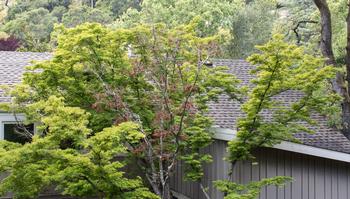 Dead leaves in the canopy were observed last season but had increased this spring, requiring pruning and disposal of the limb. Photo: Karen Gideon
Dead leaves in the canopy were observed last season but had increased this spring, requiring pruning and disposal of the limb. Photo: Karen Gideon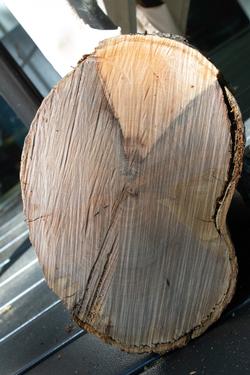 The vascular system of a maple tree was compromised by Verticillium wilt and was not delivering water and nutrients. Photo: Karen Gideon
The vascular system of a maple tree was compromised by Verticillium wilt and was not delivering water and nutrients. Photo: Karen Gideon
Most garden pathogens are species of either fungi and bacteria. Fungi are made up of thin, threadlike hyphae networked and present on or in the host plants. Bacteria are single celled organisms that sometimes feed on plants and other organic matter as composters and nutrition boosters in our soil. Fungi is spread by spores, which travel by water, wind, soil movement, and on your garden tools, shoes, and animals. Bacteria are spread by insects, birds, and infected tools and soil. All of these methods of spread are inherent in basic gardening practices and the environment.Since the micro-organisms are already in our gardens, the condition of your plants and the garden environment become key influencers in terms of what becomes infected. Aspects of susceptibility include the plant’s genetic make-up, the vigor of the host, the plant’s stage of growth and life, and the nature of the pathogen. Environmentally, two very important factors are moisture and temperature.
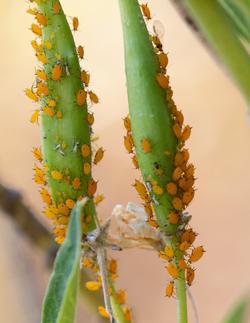 Aphids have sucking mouthparts that can cause leaf curl. They produce honeydew that can turn into black sooty mold fungus. Photo: Karen Gideon
Aphids have sucking mouthparts that can cause leaf curl. They produce honeydew that can turn into black sooty mold fungus. Photo: Karen Gideon
If the conditions are poor for pathogens, and the health of the plant is vigorous, then the pathogen may have little effect. If the conditions for the pathogen are positive and the host plant is stressed, damaged, or weak, then disease may follow. While most signs and symptoms of disease become apparent with time, the time to act is now. Careful monitoring of your plants’ health can help prevent disease by keeping your plants in tip-top shape. Diseases progress over time and the earlier it is discovered the better.Monitoring the conditions of your garden should be done on a regular basis. I use a calendar, marking changes, environmental issues, and any signs or symptoms I observe. It’s helpful if you photograph signs and collect samples.
Standing at some distance from the plant or tree, look at the canopy or the top growth. Signs of possible disease include die back, leaf droop, drop, rust, or discoloration. Inspect fruit and flowers, looking for spots, insects, oozing and boring holes. Check for peeling bark, openings in the bark, weeping, fruiting bodies or discoloration. Expose the root crown of the plant and look for signs of fungal growth or discoloration. If you have a timed irrigation system, check the frequency and length of the watering. Record and photograph insects found on the plant.
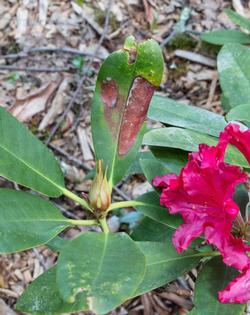 This rhododendron shows signs of Ramorum blight as the dark lesion emanates from the central vein. Photo: Karen Gideon
This rhododendron shows signs of Ramorum blight as the dark lesion emanates from the central vein. Photo: Karen Gideon
If you’re witnessing symptoms on your plant, an excellent source of information is accessible through the Master Gardener website at marinmg.ucanr.edu. Armed with the name of your plant, and your signs and symptoms, click on “Problems” on the banner bar. Next, click on “Solving Plant Problems” and find the box highlighting the Plant Problem Diagnostic Tool. This tool can give you some guidance in terms of management or treatment. Some problems can be eliminated with pruning and proper disposal of debris. Other diseases may need treatment or inspection by a certified arborist or agricultural advisor.Control of an established disease can be difficult, so prevention is critical. You can help keep your plants in good stead if you avoid over- or under-watering. Purchase disease-resistant cultivars grown locally and plant them with adequate spacing in healthy uncompacted soil. Don’t plant too deeply – keep the root crowns visible. Sanitize your tools to avoid cross-contamination and don’t forget to compost and mulch!
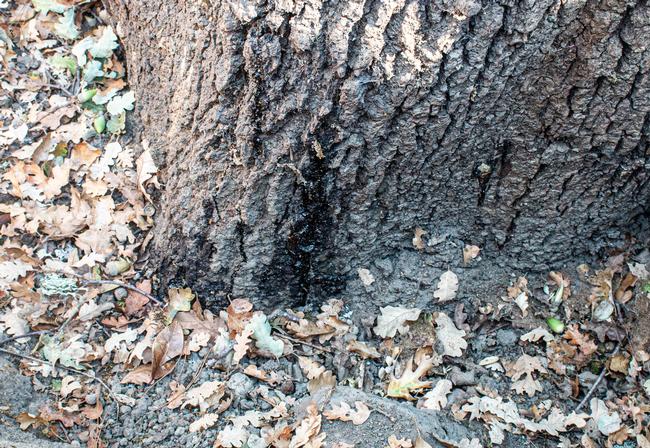 Oozing lesions in the bark were exhibited by this Valley oak, a possible symptom of Armillaria or Phytophthora fungal infection. Photo: Karen Gideon
Oozing lesions in the bark were exhibited by this Valley oak, a possible symptom of Armillaria or Phytophthora fungal infection. Photo: Karen Gideon





